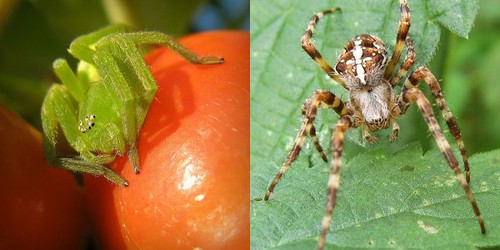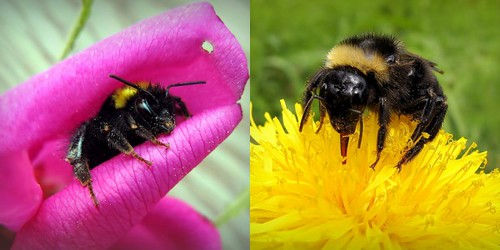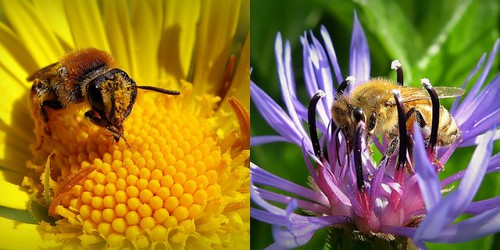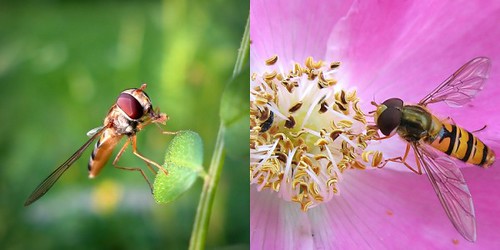~ Jawaharlal Nehru

Stalked!
Camera: Canon Powershot A710IS
Location:Punkaharju, Finland
Date & time: 5.36pm EEST
Exposure: 0.017 sec
Aperture: f/2.8
Focal length: 5.8mm
Modifications: cropping, adjusted brightness & contrast levels
I am keen on learning more about insect photography. I always read tips from some forums and blogs of professional photographers. Sometimes reading about some so-called tips make me wince. I was shocked to find out that some photographers resort to freezing bugs so that they could get 'better' photos of them. I think that is very wrong to sacrifice a bug's precious life for the sake of art. Talk about some human's selfish needs. No wonder so many species are now extinct. In my opinion such form short cutting defeats the real purpose of nature photography. There's nothing like capturing nature's priceless moments.
In case you find nature macrophotography very interesting, then by all means give it a shot. It's not exclusive to people with high-end cameras, if it was then I would not have the thousands of bugs and flower close-ups that are in my hard disk right now. I already have an entry about flower macros. For now I want to share with you how to find and stalk bugs in their natural environment.
One thing that you should do as you walk close to the subject is to adjust your camera settings. Lower the exposure if the light is too harsh. Do you think you need to change the white balance? Do all the necessary adjustments prior to getting up close to the bug.
Spiders
It's quite easy to find spiders. If not in their web, they are usually on leaves or crawling on the ground. These 8-legged creatures are not insects. They don't have wings, but once they sense your presence they will disappear in flash. Why? Because most of them have 8 eyes that's why they can easily detect human presence. Getting good photos of them is a bit difficult, but not impossible. Just don't do anything that will startle them, move very slow but press that shutter like a maniac. If you are very close, make sure that your camera won't accidentally hit the leaf or whatever the spider is on because it's going to blow your chance to take more photos. In a blink of an eye spidey will be somewhere else. Here are two spiders who didn't mind me taking photos of them:

1. Greenie
2. Spider on a stinging nettle
Bumble bees
These ever buzzing winged insects are very restless especially if they are surrounded by plenty of tiny flowers. A bumble bee will just stay on a flower for a few seconds. They are normally too busy to get intimidated by the camera, but you have to press on the shutter as fast as you can. I haven't had the luxury of time to use manual focus on bumble bees. My camera is always on full auto mode whenever I take photos of them. My best shots bumble bees:

1. Coming out of the shell
2. Another day in the office
Honey bees
If bumble bees are always in a hurry to get things done, honey bees are different. They are quite methodical. Hence, easier to photograph. You can follow it's movement from one flower to another and you can take many shots of it because it stays on a spot for a minute or more.

1. And yet another hard worker
2. Behind bars
Hover flies
I have plenty of hover fly photos in my gallery. Based on my experience, they are the easiest winged creatures to take photos of. You can find them on flowers and sometimes they rest on leaves or blades of grass. You can be just inches away from them but they would not care, except if you will shake the leaf or flower. Once you are used to taking photos of bumble bees & honey bees, then you can effortlessly photograph hover flies. You an experiment on many different angles. Hover flies are twice smaller than bumble bees, to capture more of its detail you have to be really close to them.

1. A praying hoverfly?
2. in the middle of something
Butterflies
These lovely creatures are probably everyone's favorite insect. Photographing them is quite challenging. Once you see one on a flower, approach it slowly. Your mere shadow will ruin your chance to take photos of these winged insects. So try your best not to cast your shadow over it. If you startled accidentally, it will fly away. But don't fret, because it will come back to the same spot where you saw it. I've seen it happen several times. Like when I took these photos:

1. A summer remembrance
2. Monday blues
The first time I saw a huge moth was when I was 5 years old. It was orange with beautiful patterns on its wings. The wing span of that moth as about 18-20 centimeters. It was my mom who saw it first. Until now I remember how that moth looked like. Sadly, it was the first and last time that I saw such a beautiful live moth. I saw something that looked almost like it but it was in a butterfly museum in Asia, pinned on a wall. I probably would never see anything like that in this lifetime. So while some species are still alive, let's not waste the opportunity. Photograph them while you can. A few decades from today they may no longer be around, but if you took the risk of getting up close to those critters then you will have beautiful pictures to show to your grandchildren someday.




2 comments:
Hi sis! I admire your patience in getting up close to those bugs. You've proven (to me at least) that one doesn't need a fancy or expensive dlsr camera to get great shots.
gwacie from GT
Thanks for dropping by! I appreciate your comment. I always say that cameras can never ever think :-)
Post a Comment